Guides
How to Grow and Care for Hass Avocado Trees: A Complete Guide
Have you ever dreamed of stepping into your backyard, reaching up, and picking buttery, rich avocados straight off the tree for your morning toast or smoothie bowl? If so, the Hass avocado tree (Persea americana) may be just what your garden is missing. With its evergreen foliage, delicious fruit, and undeniable charm, this iconic tree is a must-have for any home orchard.
But how do you plant it, care for Hass Avocado Trees, and ensure it rewards you with baskets of creamy avocados year after year? Whether you’re new to fruit trees or an experienced grower, this complete guide will walk you through each step of cultivating a thriving Hass avocado tree—right in your backyard.
Let’s dive in and bring your avocado-growing dreams to life!
What is Hass Avocado?
The Hass avocado is the most popular avocado variety in the world, prized for its creamy texture, rich nutty flavor, and long shelf life. Originating in California in the 1930s, it produces medium-sized, dark-skinned fruit that ripens off the tree, allowing you to harvest and store them at your convenience.
Hass trees are evergreen and can reach 15–30 feet tall, though with proper pruning, they’re easy to manage even in smaller yards or large containers. Best of all? With the right care, a single tree can yield over 200 avocados a year!
Growing Conditions for Hass Avocado
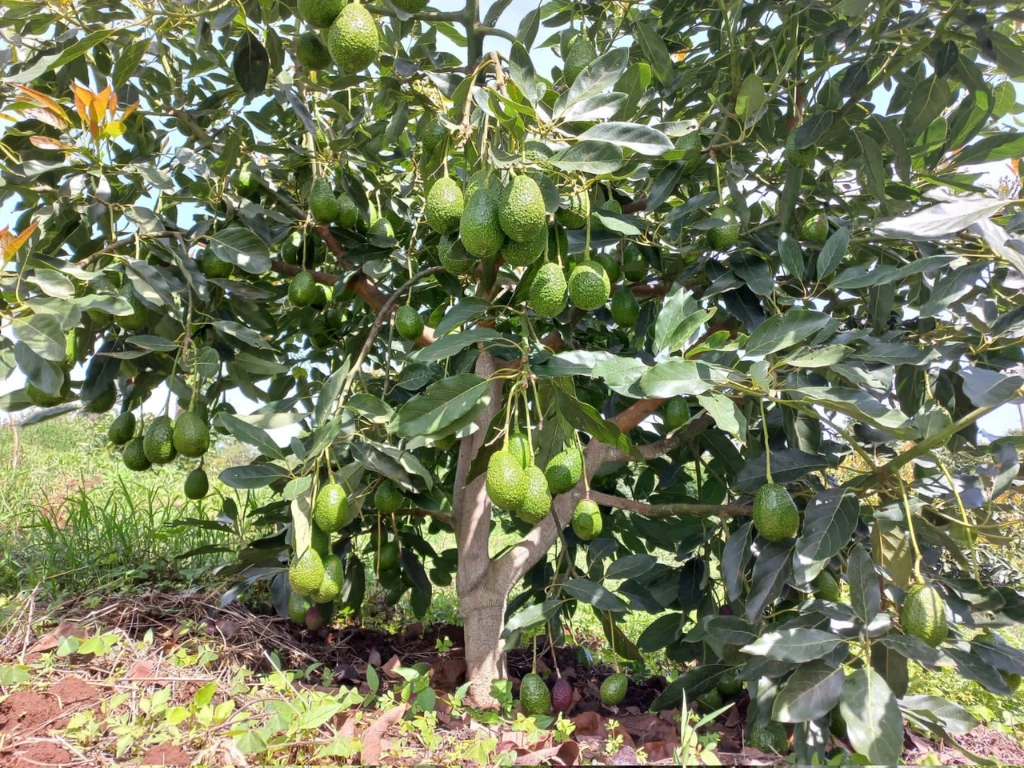
To grow a productive Hass avocado tree, you’ll need to replicate its native environment—warm, sunny, and well-drained.
Light Requirements
Avocado trees are sun-loving plants, and they really shine when basking in the full light of the day. For optimal growth and fruiting, choose a location that receives at least 6–8 hours of direct sunlight daily. This will help the tree develop strong leaves, healthy branches, and, of course, those prized fruits.
In cooler climates or areas with shorter growing seasons, you can still make it work! Try planting your Hass avocado tree near a south-facing wall or structure, which can act as a natural heat reflector. This will provide your tree with extra warmth, giving it a few more precious weeks of growing time before the cold sets in.
Soil Preferences
Well-drained soil is a must! Avocado roots are shallow and prone to rot in soggy ground.
-
Ideal soil: Loamy, sandy soil rich in organic matter.
-
pH: Slightly acidic to neutral (6.0–7.0).
-
Tip: If your soil holds too much water, consider planting in a raised bed or large container with drainage holes.
Temperature and Hardiness
-
Best suited to USDA zones 9–11.
-
Hass trees prefer temperatures between 60–85°F (15–29°C).
-
Protect young trees from frost and harsh winds—use frost blankets or plant near a structure for warmth.
How to Plant Hass Avocado Trees
Planting your tree correctly is key to years of healthy growth and abundant harvests.
Choosing the Right Tree
Select a grafted Hass avocado tree from the Nursery Plant. Avoid growing from seed unless you’re experimenting—it takes 7–10 years to fruit and may not produce true Hass avocados.
Planting Steps
-
Dig a hole twice as wide as the root ball and slightly shallower.
-
Place the tree so that the root flare (where roots meet trunk) is just above soil level.
-
Backfill with native soil mixed with compost, pressing gently to eliminate air pockets.
-
Water thoroughly to settle the soil.
-
Add a 2–3 inch mulch layer, keeping it several inches from the trunk.
-
Stake young trees if they’re in a windy location.
Pro Tip: Space trees 15–20 feet apart if planting more than one. Avocados benefit from cross-pollination (more on that below!).
Caring for Hass Avocado Trees
Watering
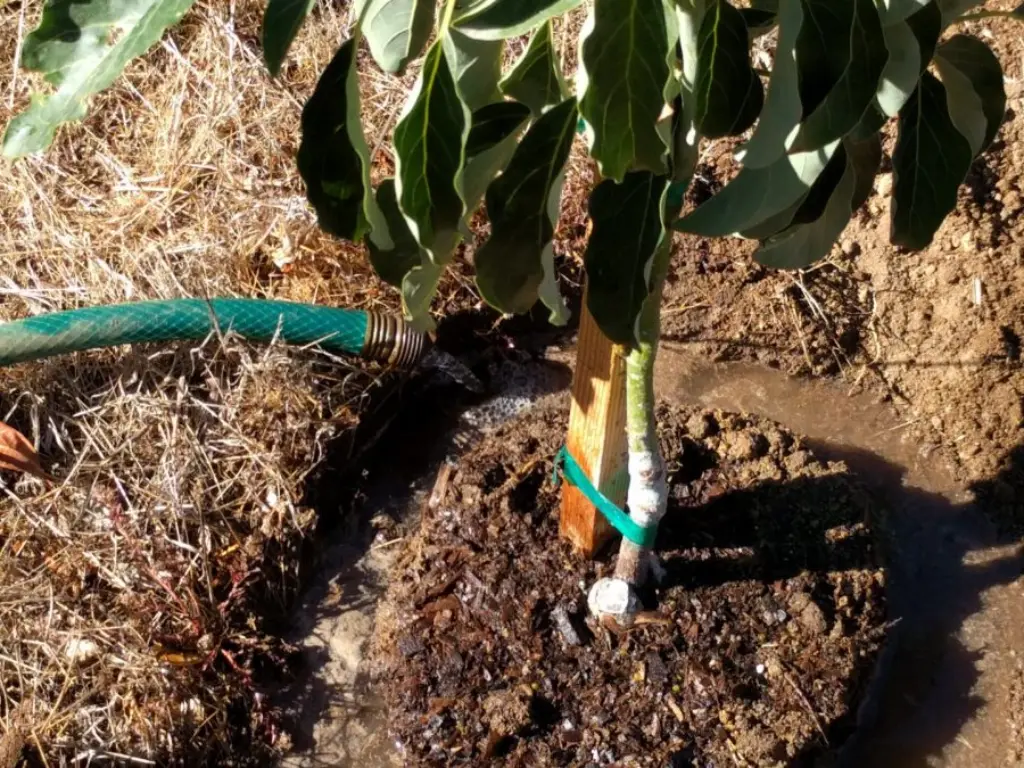
Watering is crucial, especially early on. Young avocado trees need deep, regular watering—usually two to three times per week, depending on your soil and climate. The idea is to keep the root zone moist but not soggy. Once the tree is established, you can back off to once every week or two, adjusting for heatwaves and rainfall.
-
First year: Water 2–3 times per week, keeping soil moist but not soggy.
-
Established trees: Water deeply every 1–2 weeks, more during hot spells or fruiting.
Tip: Let the top 2 inches of soil dry between waterings. Avocados hate wet feet!
Fertilizing
During spring and summer, the tree is actively growing and producing fruit, so it benefits from a balanced fertilizer that’s high in nitrogen, which supports strong root development and vigorous leaf growth. You can also opt for organic options like fish emulsion or compost tea, which nourish the tree while improving soil health.
As the seasons shift to fall and winter, it’s important to reduce fertilization. This allows the tree to enter a dormant period, where it can rest and conserve energy. Overfeeding during these months can encourage unwanted growth and might make the tree more vulnerable to cold weather.
One of the most important things to remember is to avoid over-fertilizing. While it’s tempting to give your tree extra nutrients, excessive fertilizer can lead to lush, leafy growth with fewer fruits. Always follow the recommended dosage on the fertilizer package and ensure it’s well-distributed around the base of the tree.
Pruning
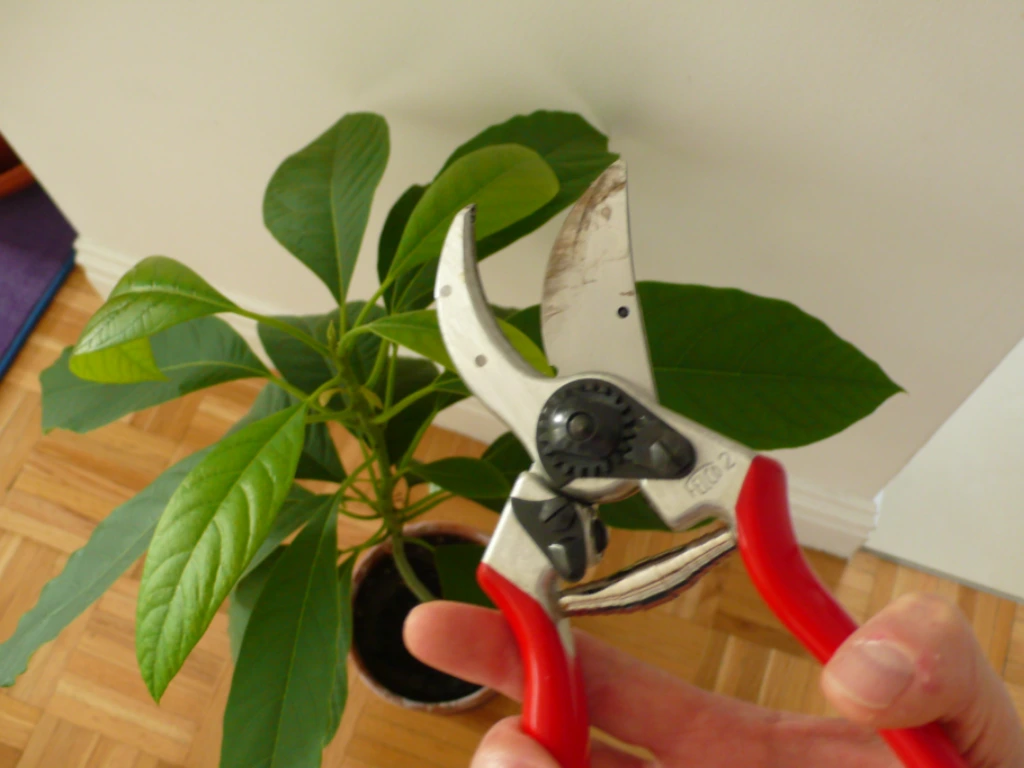
Plus, it helps keep airflow in the canopy, which is critical for reducing the risk of disease.
When to Prune:
Prune your tree lightly during late winter or early spring, before the tree gets too active for the season. This gives it a good start as the weather warms up.
What to Remove:
-
Dead or damaged branches: These take up space and energy without contributing anything.
-
Crossing branches: If branches are rubbing against each other, it can lead to damage, so trim those to keep everything neat.
-
Thinning the canopy: This helps light and air circulate, which promotes healthy growth and minimizes disease.
Size Control:
If you’re working with limited space, keep your tree in check by pruning to maintain a size that fits your garden or container. This not only makes for a prettier tree but also ensures your fruit stays within arm’s reach for easy picking. No ladder necessary!
Pollination Tips for Better Yields
Avocado trees have two types of flowers—“A” and “B” types—that open and close at different times of the day. This unique characteristic means that for the best pollination and higher yields, it’s beneficial to have both types of flowers nearby. Hass avocados are classified as an “A” type, meaning they open their female flowers in the morning and their male flowers in the afternoon. To achieve optimal pollination, it’s helpful to plant a “B” type avocado tree (like Bacon or Zutano) nearby, as these open their female flowers in the afternoon and their male flowers in the morning. This timing overlap ensures better cross-pollination.
If you’re short on space and can’t plant two trees, don’t worry! Bees and other pollinators, along with warm weather, can still help a single Hass tree produce fruit, especially if it’s planted in a sheltered, sunny spot where the tree can attract more pollinators. With a little attention to the planting location and some help from nature, even a single tree can yield a bountiful harvest.
Harvesting and Using Hass Avocados
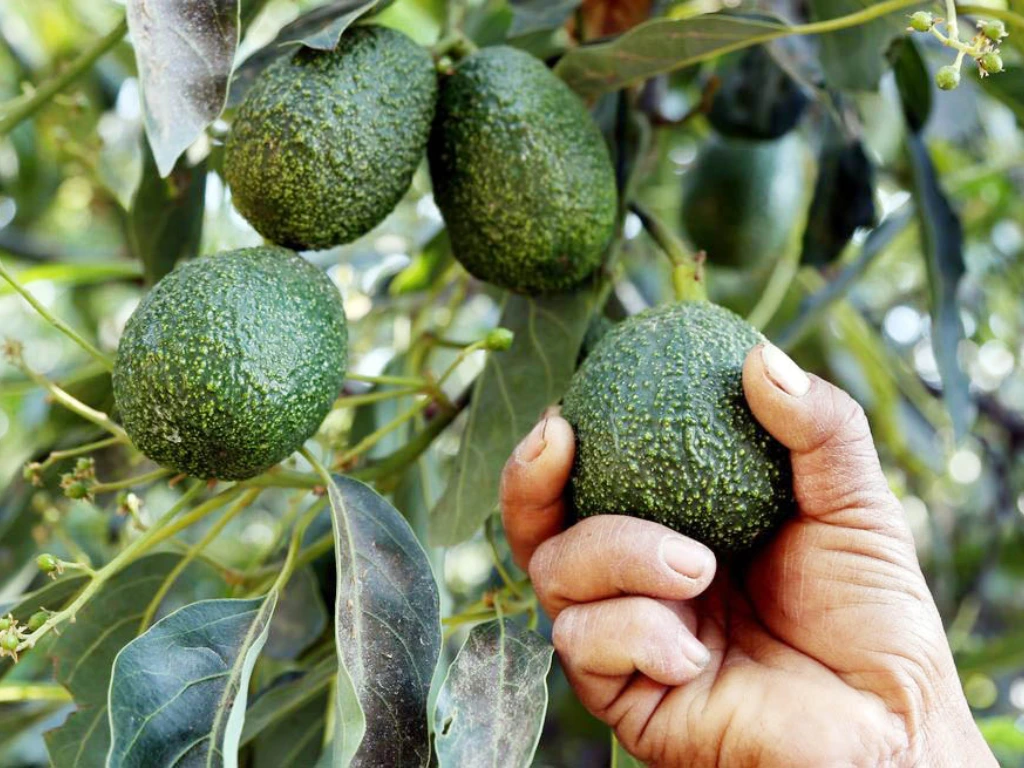
When to Harvest
Hass avocados typically mature between late spring and summer, depending on your local climate. You’ll notice the fruit gradually changing color and growing larger, but the real test comes when you pick one. Gently twist it off the tree and let it ripen indoors. If it softens within 7–10 days, your tree is ready for harvest.
Pro Tip: Avoid leaving the fruit on the tree too long. While avocados may continue to ripen after being picked, overripe fruit can lose quality and flavor. It’s best to harvest steadily as the fruit begins to ripen.
How to Use Your Avocados
Once you’ve harvested your Hass avocados, it’s time to enjoy them in a variety of ways:
-
Sliced on toast for the perfect breakfast or snack
-
Tossed in salads for a creamy, delicious boost
-
Blended into guacamole or smoothies for a rich, velvety texture
-
Made into avocado oil or butter for cooking or spreading
-
Frozen to preserve them for future use, perfect for smoothies or baking
Bonus Tip: Don’t leave fruit on the tree too long—it can lose quality. Harvest steadily once ripening begins.
Common Issues and Solutions
-
Root rot: Caused by poor drainage. Improve soil or use containers.
-
Leaf tip burn: Often due to salt buildup. Flush soil with deep watering.
-
Yellow leaves: Could signal overwatering or nutrient deficiency—check soil moisture and fertilize appropriately.
-
Pests: Watch for mites, thrips, or scale. Treat with neem oil or insecticidal soap if needed.
Conclusion
Hass avocado trees are more than just a fruit source—they’re a long-term investment in beauty, health, and homegrown abundance. With the right site, care, and patience, your tree can become a centerpiece of your garden and your kitchen.
Ready to plant your first Hass? Grab a sunny spot, dig in, and get ready for buttery avocados straight from your backyard.
You may also like:

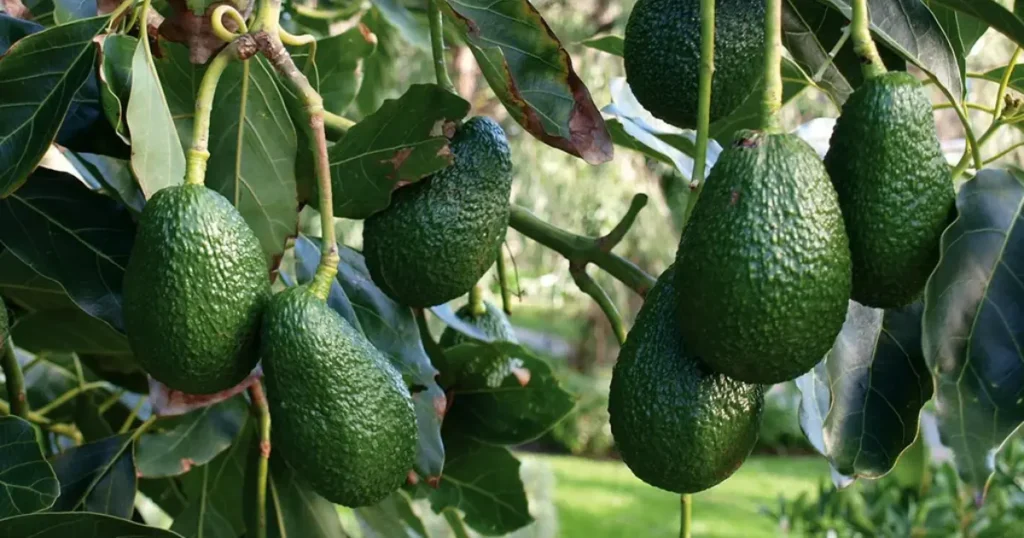
10 Best Christmas Plants to Gift This Holiday Season
The holiday season is finally upon us, and if you’re searching for the perfect gift [...]
Oct
Top Reasons to Grow Your Own Curry Leaf Plant at Home
Have you ever walked through your local grocery store and noticed the small bundles of [...]
Oct
Best Types of Garlic You Must Grow Once in Your Garden
Have you ever tossed a clove of garlic into the pan, expecting an aromatic burst, [...]
Oct
How to Propagate Vinca Minor: Simple Steps for a Lush, Spreading Ground Cover
Have you ever admired the beautiful carpet of glossy green leaves and purple-blue flowers of [...]
Oct
9 Best Ground Cover Plants to Prevent Weeds
We all know that keeping weeds at bay can be one of the most challenging [...]
Oct
How to Propagate Christmas Cactus: Easy Methods for Thriving Holiday Plants
Have you ever wished you could have more of those beautiful, blooming Christmas cacti to [...]
Oct